Hospital Farming For Better Health
Air Date: Week of July 13, 2018
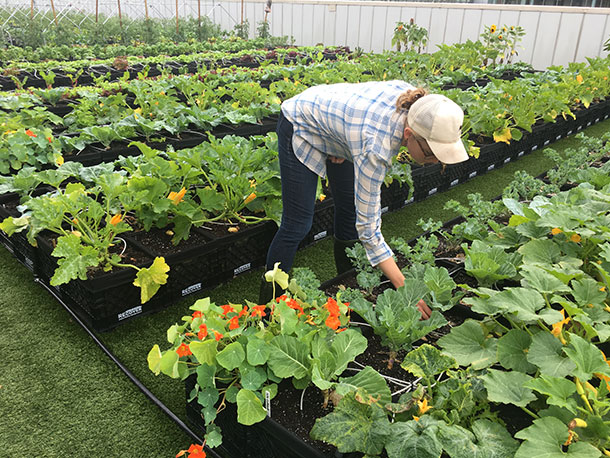
Farm manager Lindsay Allen says that Boston Medical Center’s rooftop farm features roughly two dozen crops. (Photo: Jaime Kaiser)
Boston Medical Center, a major trauma center and teaching hospital, is reimagining what it means to care for patients, with a new rooftop agriculture project. Living on Earth Host Jaime Kaiser visited the hospital to learn more about the farm, which is providing fresh produce for patient and employee meals.
Transcript
CURWOOD: Hey Jaime, I heard you were in a hospital recently?
KAISER: I was, but don’t worry, I’m in fine health.
Curwood: Oh, good but hey, why were you there?
KAISER: I actually stopped by Boston Medical Center to check out a new farm they’ve
started up.
CURWOOD: A hospital that’s farming?
KAISER: [LAUGH] I was surprised too…
[CITY AMBI]
KAISER: For one Boston hospital, feeding patients is about more than taking in calories. Food is medicine here, and they’re getting that food from an unusual location.
ALLEN: We’re up here on the rooftop farm here at Boston Medical Center. And right now we are on top of the powerplant shipping and receiving building.
KAISER: That’s Lindsay Allen. She’s the manager of Boston Medical Center’s rooftop farm. It’s considered the first in New England. Allen joined the BMC staff last year as its first farm manager. What was once a flat black roof provides prime real estate for roughly 25 varieties of fruits and vegetables that feed hospital patients, visitors, and employees.
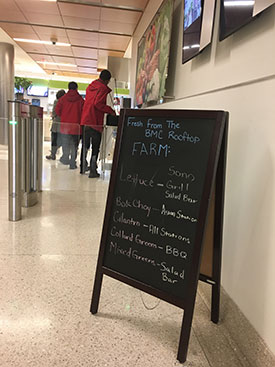
A sign advertises BMC’s farm offerings on a sign outside the cafeteria entrance. (Photo: Jaime Kaiser)
ALLEN: My biggest surprise within the first week was just how well the plants did. I was really worried that they weren’t going to grow that well, and they were so happy and grew faster than anywhere I’d ever farmed. We planted and then five weeks later we were harvesting radishes, salad mix, lettuce heads, and that definitely surprised me.
KAISER: The farm takes up 2400 square feet of space, just 1/16 of an acre. Nevertheless, Lindsay and her team were able to grow over 5000 pounds of produce in 2017, and they hope to grow a similar amount this year.
All her crops are organized in neat, long rows of milk crates.
ALLEN: So we have 2300 milk crates here, and then each milk crate has a recycled, woven fabric – plastic fabric – that allows for drainage and air to move.
KAISER: The farm works in tandem with other initiatives like a food pantry for food-insecure patients and a hospital farmer’s market.
ALLEN: It’s really integrated into a fuller picture of what it means to care for people in a way that I think more hospitals should be doing.
[FOOTSTEPS]
ALLEN: So if we walk over here, this… so this was a section that was planted first on the farm. And it’s a mix of crops that I can keep harvesting from. So this is like collard greens, kale here – that I will continue for like two to three months to harvest and make bundles from. And then we’ve intercropped some of our more summer-specific crops so we have Poblano peppers here, I have a lot of bell peppers, a few habaneros.
KAISER: To our right, a series of wire domes poke out of a row of crates.
ALLEN: These are all hoop houses that we added for season extension. So in the springtime and in the fall we cover this with row cloth, these hoops, and that way it mitigates against frost and creates a little bit of a microclimate so that we can start earlier than if it were just all open. And then in the fall that allows us to keep growing until about mid-November.
[MORE WALKING]
KAISER: Allen leads the way to another set of crates.
ALLEN: Let’s see… this is a huge patch of carrots that are almost ready. I planted them to time so that when we have our summer camps up here in two weeks, the kids can help me harvest carrots because it’s a really rewarding and fun experience if you haven’t harvested carrots. You have this green top and I kind of think of it as a nice surprise when you pull in out. Or, I’ve had kids up here that scream as they pull it out not knowing what was actually below the soil.
KAISER: Then she walks around to the other side of the row.
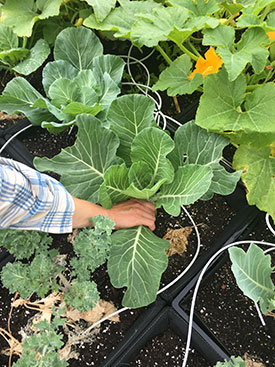
Lindsay harvests collard greens from the soil. (Photo: Jaime Kaiser)
ALLEN: These are all the cucumbers on this side. So we have three different varieties of cucumbers. Then we have Bock Choy that’s interplanted and basil plants as well interplanted with the tomatoes and the peppers.
KAISER: Interplanted to maximize urban growing space, and encourage a variety of beneficial insects to pay a visit.
ALLEN: I try to think of this farm as much of an ecosystem as possible. How do we keep all of the scraps that we aren’t actually using for food, keep them on site, so that we can continue to create soil and compost up here and then we also have bees to pollinate. And… and then we get honey. So that’s always a plus with keeping bees.
KAISER: Where are the bees?
ALLEN: They are – we can walk over here…
ALLEN: They will be inside their hives today but we can peek at them… oh, there are a few coming in and going, they’re brave.
KAISER: Two bee boxes, each crammed with thousands of bees!
[FADE IN CAFETERIA / LOBBY AMBI]
KAISER: For a look at how all that farm fresh food makes it to patient plates, I head over to the cafeteria.
BURG: Hi, my name is Tracey Burg. I’m the culinary nutrition manager at Boston Medical Center’s Teaching Kitchen.
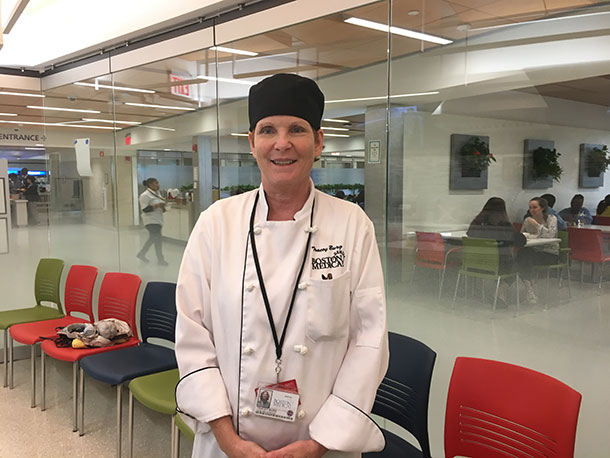
Tracey Burg is a registered dietitian and the Head Chef of the teaching kitchen. (Photo: Jaime Kaiser)
KAISER: The teaching kitchen is a healthy food project that got its start before the farm. Each class incorporates fresh food from the farm into cooking lessons that demonstrate BMC’s food as medicine philosophy.
BURG: Our classes are free, we invite anybody to come in, but also people with heart disease, diabetes, cancer, renal patients. They come in for classes and we talk about disease-specific foods and cooking techniques that are healthy for them.
KAISER: I visit Tracey during one of her classes. For her first dish, she whips out a blender from one of the cabinets behind her.
BURG: Alright, so, this sherbet recipe has two ingredients… this mango here… and then we’re gonna add one cup of vanilla greek yogurt. And then a little bit of water.
And then we’re gonna blend this up.
[BLENDER WHIRRS]
KAISER: She also adds a dollop of honey – straight from the bees on the farm.
For the main course, Tracey grabs a cucumber out of the fridge and begins to chop.
BURG: Tabouleh is wheat chopped up. And we’re gonna put some parsley in here. You can use mint too. Parsley and mint taste delicious in tabouleh. I was taking the mint from our farm yesterday.
KAISER: Tracey says the farm has been a huge asset to her work in the kitchen.
BURG: Oh, well, the farm’s great. I mean, I get my produce from there. But it’s also, it’s a learning space for us too. So I bring all my groups up there at some point during the growing season. And we pick the vegetables up there, we bring it down to the kitchen, and we cook it. And so it’s kind of like farm to table right in front of them.
KAISER: The farm has been a remarkable addition to the neighborhood too – the South End of Boston was once considered a food desert. Again, farm manager Lindsay Allen.
ALLEN: There’s a few grocery stores now popping up, but it’s a pretty intense part of the city that not only has food access issues but there’s also no green space around here.
KAISER: Despite the role that fresh fruits and vegetables have in staying healthy, people are often shocked to learn about the hospital’s rooftop farm.
ALLEN: Most people associate hospitals with terrible food, which is really interesting because right when we’re at our most vulnerable at hospitals, you’d think that would mean we need nourishing food.
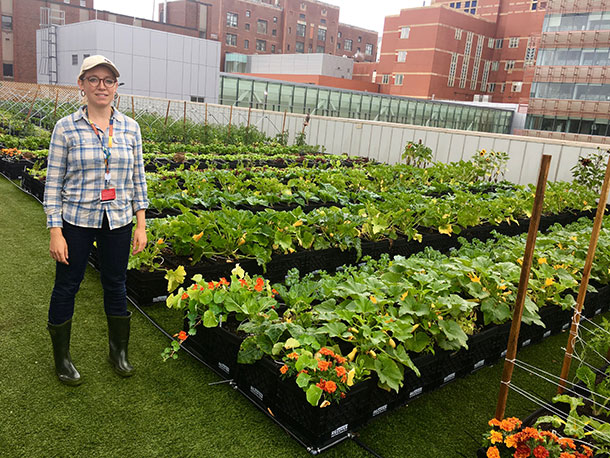
The BMC farm produced roughly 5000 pounds of produce in 2017. (Photo: Jaime Kaiser)
KAISER: Lindsay says that Boston Medical Center’s approach is a holistic take on healthcare that looks beyond the immediate needs of their patients. Right now, they’re also looking forward to a bumper crop of tomatoes.
CURWOOD: Thanks for that report, Jaime. Hey, did you get try anything?
KAISER: Yep, I did… that mango sherbet is awesome.
CURWOOD: I’m jealous.
Links
Living on Earth wants to hear from you!
Living on Earth
62 Calef Highway, Suite 212
Lee, NH 03861
Telephone: 617-287-4121
E-mail: comments@loe.org
Newsletter [Click here]
Donate to Living on Earth!
Living on Earth is an independent media program and relies entirely on contributions from listeners and institutions supporting public service. Please donate now to preserve an independent environmental voice.
NewsletterLiving on Earth offers a weekly delivery of the show's rundown to your mailbox. Sign up for our newsletter today!
 Sailors For The Sea: Be the change you want to sea.
Sailors For The Sea: Be the change you want to sea.
 The Grantham Foundation for the Protection of the Environment: Committed to protecting and improving the health of the global environment.
The Grantham Foundation for the Protection of the Environment: Committed to protecting and improving the health of the global environment.
 Contribute to Living on Earth and receive, as our gift to you, an archival print of one of Mark Seth Lender's extraordinary wildlife photographs. Follow the link to see Mark's current collection of photographs.
Contribute to Living on Earth and receive, as our gift to you, an archival print of one of Mark Seth Lender's extraordinary wildlife photographs. Follow the link to see Mark's current collection of photographs.
 Buy a signed copy of Mark Seth Lender's book Smeagull the Seagull & support Living on Earth
Buy a signed copy of Mark Seth Lender's book Smeagull the Seagull & support Living on Earth

